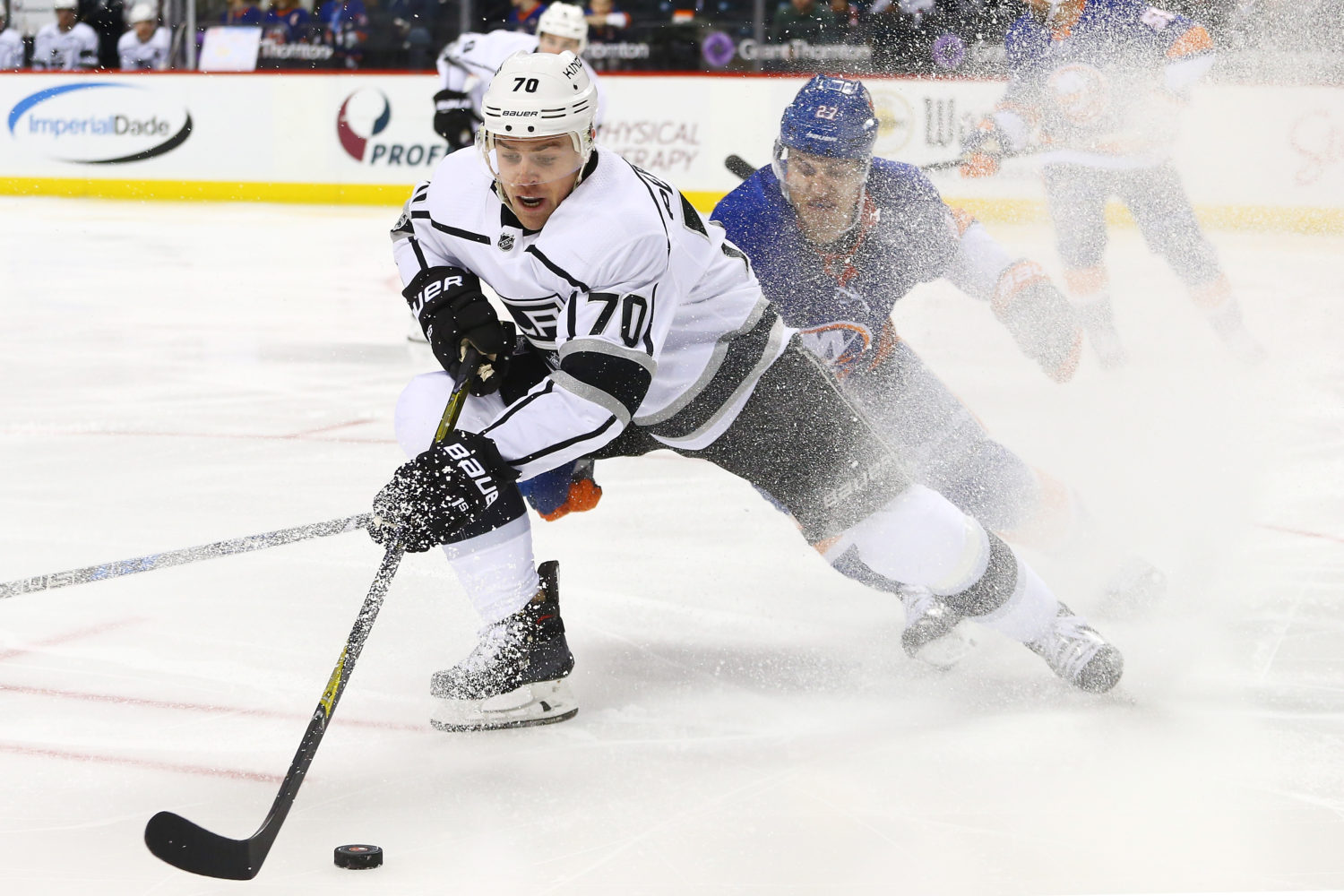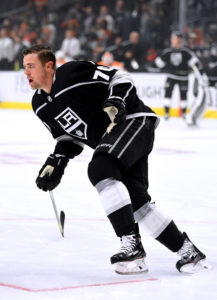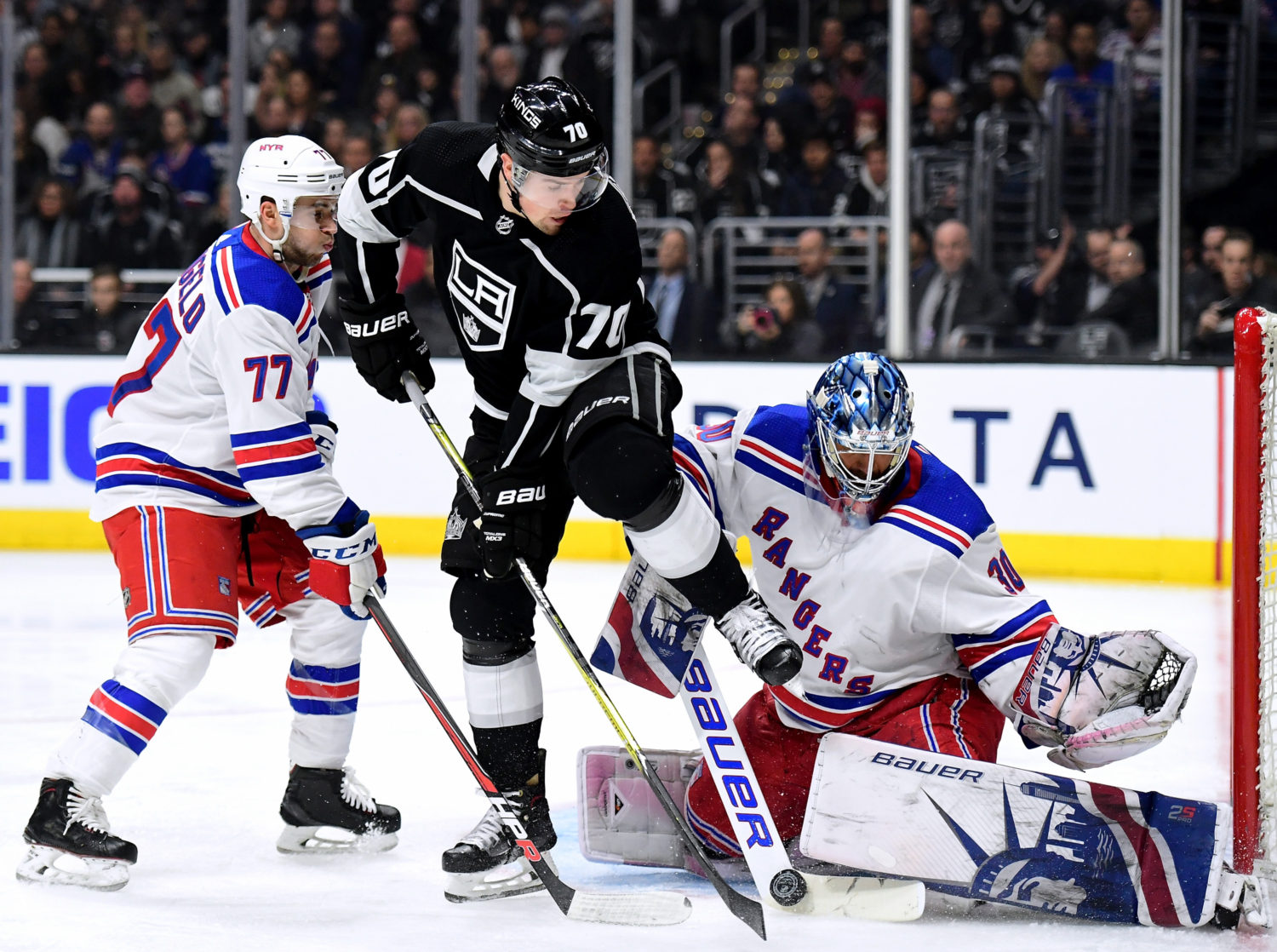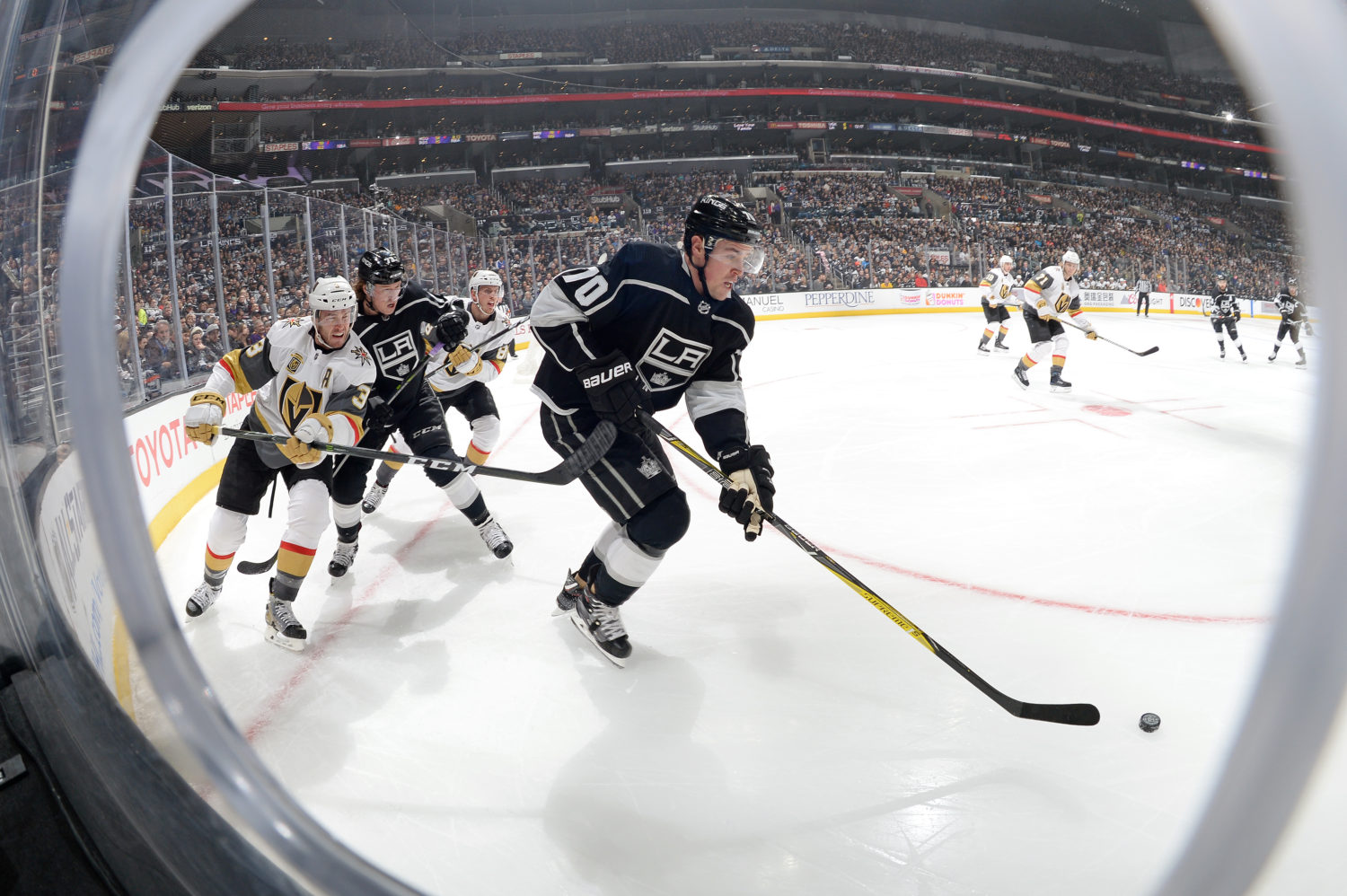This season: 82 games, 15 goals, 25 assists, 40 points, 27 penalty minutes, +11 rating, 180 shots, +2.7% CF%Rel, 1.017 PDO, 15:58 time on ice
The good: The 2017-18 season was a peculiar one for Tanner Pearson, who battled some early season inconsistency to get his game to a pretty good place but wasn’t able to consistently transfer his work, pace and detail into regular scoring while experiencing a nine-goal dip in production. Despite a raised PDO, he probably deserved a little bit better. The numbers were actually pretty interesting: the Kings were a notably high-event team, both for and against, when some combination of players like Tanner Pearson, Tyler Toffoli, Adrian Kempe and Jeff Carter were on the ice in five-on-five play. With a team-best 3.1 on-ice GF/60, it really appears as though the Kings were scoring goals when Pearson was playing; he just wasn’t the one scoring them. Los Angeles shot 9.4% with the 25-year-old on the ice – the third best on-ice shooting percentage on the team – and yet he scored only nine of the 53 goals that he was on the ice for. During many of those goals, he was often doing the dirty work that helped force them, whether forechecking or making hard wall plays on the perimeter, or getting to the front of the net as the Kings’ next-best goalie screener to Dustin Brown. “There’s certainly a lot of small things in his game to lead to good things for the hockey team,” John Stevens said in December.
There were some lulled moments of production early in the season and around the turn of the new year, but Pearson has shown to be a good pro who does a good job fine tuning his own game. Dating back to last summer, he solicited John Stevens for a map of where his scoring chances were coming from, an area and topic revisited throughout the season.
Pearson hits the net both as a shooter with a blistering wristshot and as a north-south, forechecking forward who gets opportunities around the front of the net. Midway through last summer, he reached out to John Stevens to get a spreadsheet and some data of where his chances and goals were coming from.
“If you look at a lot of stuff, it was in that ball/diamond type area from the net,” he said. “Even if you look at the league, that’s where 90% of the goals are from. You want to get opportunities from there because you have a higher percentage of getting a goal.”
“Even Billy (Ranford) puts up stuff of where goals are scored on certain goalies, and the closer you get in, the higher the percentage is,” he continued. “Small things like that, but when you look at it, it makes a lot of sense.”
It was a subject he revisited with the team around the Christmas break, towards the end of the first half of the season.
“I needed a reminder of where I needed to get my chances,” he said. “With that spreadsheet, there did come video, too, with it. You’re able to watch it. At this day and age, you can pretty much get it wherever you want, so it’s just a matter of asking for it and looking at it.”
Pearson continued to play in all situations for the team, serving on the second power play unit and forming part of the deep and effective eight-man penalty killing rotation. And, remarkably, he continued to be a terrific late-game finisher with two more overtime goals, giving him seven OT daggers through 342 career regular season and playoff games. 17 of his 603 career shots have resulted in game-winning goals. He also proved to be capable of drawing penalties with a team-best 24 drawn (and only nine taken); his 1.4 penalties drawn per 60 minutes was the second-best rate on the team. With his first 82-game season under his belt, Pearson has now appeared in 162 straight games for Los Angeles and hasn’t missed a game due to injury since returning from his broken fibula at the start of 2015-16. Also, let’s not overlook his career-high 25 assists (which came on eight primary assists and a career-high 11 secondary assists).
The bad: So many of these efforts and direction-based metrics legitimately help the team win games, but the Kings were sounding a call for secondary offense the moment the season ended. Pearson, along with several other players, is part of a group that will be measured in large part by their production, and this was a down year for several key names at key times, including Pearson, who ended the year with a 13-game goal scoring drought through the Vegas series. Los Angeles places emphasis on the number of shots and scoring chances derived from the forecheck, and Pearson, who has underrated speed and a devoted willingness to get his hands dirty and win battles and races to pucks, didn’t have his game firmly in order at the start of the season, which affected the ability to apply pressure and generate zone time early on. (It also placed heavy emphasis on Jonathan Quick, whose .937 save percentage through November 7 was a grand influence on Los Angeles’ 11-2-2 start.) But as Pearson’s game generally trended well throughout the year, he never saw a spike in an anomalously low shooting percentage until mid-March. Scoring five times in nine games helped correct the market a touch, but Pearson’s all-situational 8.3% was a career-low for a player who had consistently maintained a high percentage in his career, clocking in at an elevated 12.8% to begin 2017-18. In five-on-five play, Pearson’s shooting percentage ranked second on the team in 2014-15, sixth in 2015-16 and led all qualified L.A. skaters in 2016-17. This past year, it ranked 15th at 6.8%, placing him between Alex Iafallo and Andy Andreoff.
I’m not sure if Pearson’s 1.017 PDO depicts a player who received a fair shake of luck this season, but rather a player that was on the ice for a surplus in goals-for, and to a slightly lesser extent, goals-against. He simply didn’t seem to be getting the same tips and bounces (and perhaps he wasn’t getting to the same pucks around the net) as in earlier years, and it’s likely that an injury to the right-shooting (and passing) Jeff Carter may have affected where the left winger was receiving the puck in the offensive zone. All other aspects of his game seemed to be in pretty good working order, especially over the second half of a season in which he continued to make plays along the boards, work pucks in deep and raise his battle element as the games toughened up. He just didn’t score a ton, personally, and as a player who potted 25 during the parched 2016-17 season, wasn’t able to transfer heavier off-season hype and direction into cold, hard production while in his prime. “We’re not always going to judge his value in terms of his play on straight production points, just like we haven’t done that with Alex [Iafallo],” John Stevens said in December. “Alex has played a terrific game for us where he doesn’t get points, but he’s critical to the success of the line and the team. I think Tanner can be like that, but he’s not a young guy anymore. He’s a veteran that we rely on for leadership and consistency.” Surprisingly, Pearson, who helped drastically tilt the ice and momentum in timely moments during the marathon 2014 run, has gone six straight playoff games without a point since his Game 3 overtime winner in San Jose in 2016.
Going forward: One year after a career-high 25 goals, Pearson fell short, production-wise, of what would be expected from a top-six forward hitting his prime amidst an evolving mindset towards attacking hockey. He’s a borderline primary-secondary scorer, and after a playoff series in which Los Angeles scored three goals in four games, the net for wider secondary contributions was cast. Pearson’s mostly good secondary numbers, along with an eye test suggesting he was still playing on the right side of puck for much of the season, colluded to indicate that even as his game came along, he wasn’t really being rewarded, and as well as he handled it, it still something that weighed on a goal scorer historically capable from both close quarters and longer range. There’s absolutely some potential for a scoring rebound here, but likewise, there are still questions about the ceiling for a player who has only 10 five-on-five goals over his last 101 regular season and playoff games. He scored 25 in a season in which the team didn’t score much at all, so is there still some potential for him to score 30? This past year’s data didn’t support that, but any discussion here is far from final, and Pearson, a good pro, will be hungry to rebound after posting lukewarm production.
Pearson has three years remaining on his contract, which carries a $3.75M AAV. The Kings’ more recent focus has been to retain its assets in building around its high-profile players, and certainly more will continue to be asked from a mid-20’s group looking to solidify reinforcement beyond the team’s experienced and productive core. There are a few surface-level similarities between Pearson and Toffoli’s seasons, and whenever “secondary scoring” seems to creep into a sentence, there’s an underlying implication that both could stand to raise their output and at more opportune times. “I think those are going to be two guys that are going to be key for us to become a better offensive team and have more consistency in our game to be able to win tight games,” Stevens said after the season. “Those guys are 200-foot players that play in all situations and have both won before. I think they’re guys we can lean on heavily but they’re guys that we’ve got to help become better players.
Pearson evaluations: 2017 | 2016 | 2015 | 2014
Player evaluations: #3 DION PHANEUF | #5 CHRISTIAN FOLIN | #6 JAKE MUZZIN | #7 OSCAR FANTENBERG | #8 DREW DOUGHTY | #9 ADRIAN KEMPE | #10 TOBY RIEDER | #11 ANZE KOPITAR | #13 KYLE CLIFFORD | #15 ANDY ANDREOFF | #19 ALEX IAFALLO | #22 TREVOR LEWIS | #23 DUSTIN BROWN | #24 DEREK FORBORT | #27 ALEC MARTINEZ | #32 JONATHAN QUICK | #44 NATE THOMPSON | #52 MICHAEL AMADIO | #70 TANNER PEARSON | #71 TORREY MITCHELL | #73 TYLER TOFFOLI | #77 JEFF CARTER | KUEMPER / CAMPBELL | THE OTHERS
-Advanced stats via Natural Stat Trick, Corsica
-Lead photo via Mike Stobe/NHLI






Rules for Blog Commenting
Repeated violations of the blog rules will result in site bans, commensurate with the nature and number of offenses.
Please flag any comments that violate the site rules for moderation. For immediate problems regarding problematic posts, please email zdooley@lakings.com.